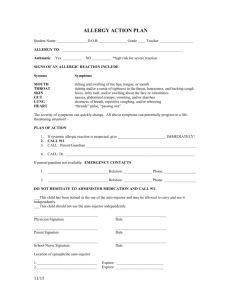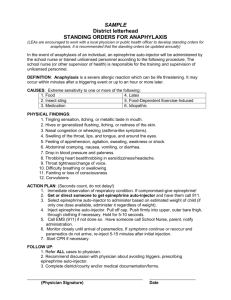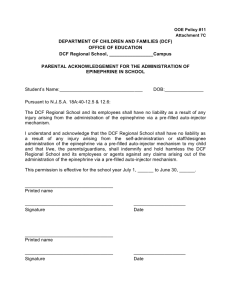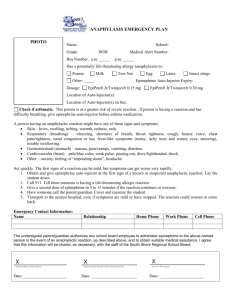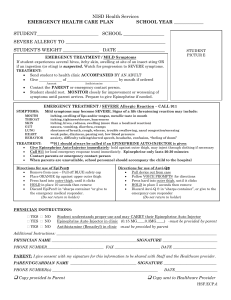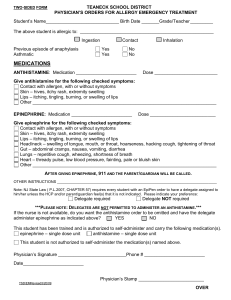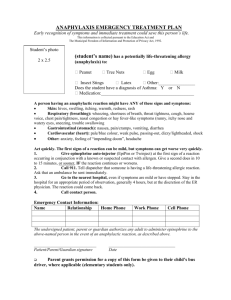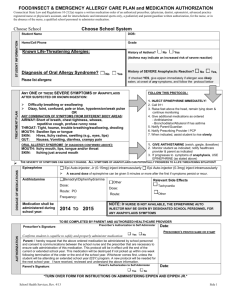TRAINING A DELEGATE FOR
advertisement
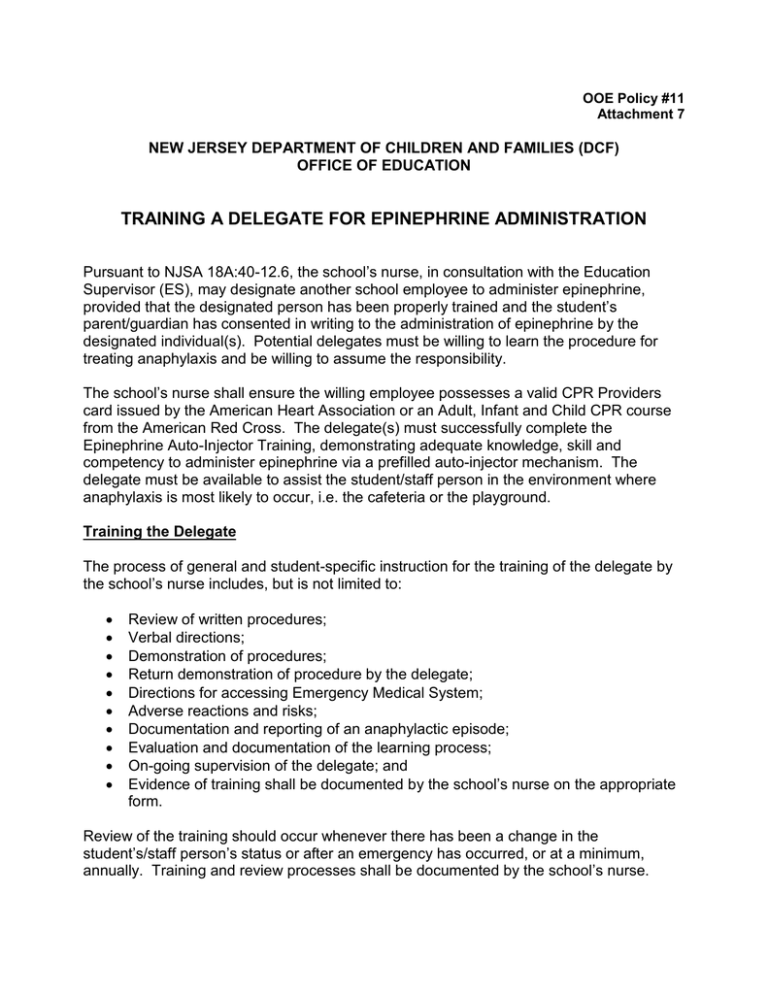
OOE Policy #11 Attachment 7 NEW JERSEY DEPARTMENT OF CHILDREN AND FAMILIES (DCF) OFFICE OF EDUCATION TRAINING A DELEGATE FOR EPINEPHRINE ADMINISTRATION Pursuant to NJSA 18A:40-12.6, the school’s nurse, in consultation with the Education Supervisor (ES), may designate another school employee to administer epinephrine, provided that the designated person has been properly trained and the student’s parent/guardian has consented in writing to the administration of epinephrine by the designated individual(s). Potential delegates must be willing to learn the procedure for treating anaphylaxis and be willing to assume the responsibility. The school’s nurse shall ensure the willing employee possesses a valid CPR Providers card issued by the American Heart Association or an Adult, Infant and Child CPR course from the American Red Cross. The delegate(s) must successfully complete the Epinephrine Auto-Injector Training, demonstrating adequate knowledge, skill and competency to administer epinephrine via a prefilled auto-injector mechanism. The delegate must be available to assist the student/staff person in the environment where anaphylaxis is most likely to occur, i.e. the cafeteria or the playground. Training the Delegate The process of general and student-specific instruction for the training of the delegate by the school’s nurse includes, but is not limited to: Review of written procedures; Verbal directions; Demonstration of procedures; Return demonstration of procedure by the delegate; Directions for accessing Emergency Medical System; Adverse reactions and risks; Documentation and reporting of an anaphylactic episode; Evaluation and documentation of the learning process; On-going supervision of the delegate; and Evidence of training shall be documented by the school’s nurse on the appropriate form. Review of the training should occur whenever there has been a change in the student’s/staff person’s status or after an emergency has occurred, or at a minimum, annually. Training and review processes shall be documented by the school’s nurse. Assessment of a Possible Anaphylactic Reaction by the Delegate The delegate shall be trained to: Assess the scene for safety; Maintain universal blood and body fluid precautions; Maintain an open airway and assist ventilations as needed; Assess level of consciousness, check for Airway, Breathing and Circulation (ABC’s of CPR) and vital signs, if possible. Obtain appropriate history relative to the allergic event; and Determine if student/staff person is in distress; Mild Distress: itching, isolated urticaria (hives), nausea, no respiratory distress; Severe Distress: stridor (a harsh, high-pitched sound in inhalation or exhalation), bronchospasm (spasm of the bronchial system, causing a persistent involuntary cough), severe abdominal pain, respiratory distress, tachycardia, shock (systolic blood pressure <90), observe for edema of lips, tongue or face or generalized urticaria. Treatment for Anaphylaxis The following protocols are to be used as guidelines to complement specific written physician’s orders. If the student/staff person presents in Severe Distress, as defined above, the procedure is as follows: Be sure the medication is what is prescribed for the student/staff person; Check the color of the medication (if able to see) and expiration date. If the medication is discolored (yellow) or expired, do not use and call 9-1-1 immediately, if the call has not been made; Carefully remove the safety cap for the single dose, auto-injector; Place the single dose, auto-injector against the lateral portion of the student’s/staff person’s thigh, midway between the waist and knee; Push the single-dose, auto-injector firmly against the thigh until the injector activates; Hold the single dose, auto-injector in place for at least 10 seconds or until the medication is injected. Massage the site for 10 seconds. Call 9-1-1, if the call has not been made, even if the person’s symptoms appear to have resolved; Call the school nurse or, if unavailable, a school administrator; Continue to monitor ABC’s. If respiratory or cardiac arrest occurs, begin rescue breathing or CPR; If student/staff person is able to swallow and a pre-measured antihistamine medication has been prescribed and available, assist the student/staff person with the administration of the medication. Discard the injector mechanism in the appropriate manner; 2 Record on the Emergency Plan – Follow-Up Documentation form the time, dose, medication, vital signs (if able) and any changes in the student’s/staff person’s condition after assisting with/giving the epinephrine; and Give Emergency Plan – Follow-Up Documentation form to School’s nurse for inclusion in the student’s health record. Documentation and Evaluation Review of the training should occur whenever there has been a change in the person’s status or after an emergency has occurred, or at a minimum, annually. The school’s nurse shall document the initial and review training by completing the Epinephrine AutoInjector Training Form. 3 OOE Policy #11 Attachment 7A NEW JERSEY DEPARTMENT OF CHILDREN AND FAMILIES (DCF) OFFICE OF EDUCATION DCF Regional School, ___________________Campus TRAINING A DELEGATE EPINEPHRINE AUTO-INJECTOR TRAINING CHECKLIST Student’s Name:________________________ Instructor:_____________________________ Title:________________________ Person Trained:________________________ Title:________________________ Demo Date Date Return Demonstration Date Date Date A) Background Information Understands the concepts of universal precautions States definition of anaphylaxis States trigger and symptoms for child States potential adverse reactions Knows how to check pulse and respiration B) Care of Anaphylactic Reaction Completes a full initial assessment (history, symptoms, vital signs) Determines need for epinephrine Checks for right medication, right child Checks medication for expiration date and color (if discolored or expired, do not use) Removes safety cap from injector Places auto-injector against lateral aspect of thigh Pushes auto-injector firmly against thigh until injector activates Holds for a minimum of ten (10) seconds Calls 9-1-1 with history and location Continues to assess cardiac and respiratory status. Begins CPR if appropriate Documents medication, dose, time and place of administration on Emergency Plan - Follow-up Documentation Form Disposes injector properly Notifies school nurse or school administrator of event State Prerequisites and Rationale for administering oral antihistamine I hereby acknowledge that I have been trained in the administration of epinephrine according to the protocol outlined above. __________________________________ ____________________________ Trainee’s Signature Date CPR Card Expiration Date:______________________________________ Date OOE Policy #11 Attachment 7B DEPARTMENT OF CHILDREN AND FAMILIES (DCF) OFFICE OF EDUCATION DCF Regional School, _________________Campus TRAINING A DELEGATE PERMISSION FOR EPINEPHRINE INJECTION DURING SCHOOL Student’s Name:______________________________ DOB:_______________ I request the school’s nurse or trained designee administer the Epinephrine and premeasured antihistamine that I have provided for the above-named student. The school personnel, other than the school’s nurse, who are trained to administer epinephrine are: 1.___________________________________ 2.___________________________________ 3.___________________________________ Identify the specific food, drug or other substance to which the above-named student is allergic: _______________________________________________________________________ ______________________________________________________________________ I request the school’s nurse or trained designee provide epinephrine and premeasured antihistamine whenever there is evidence of hives, rashes, tingling, itching, respiratory distress or other sign of allergic reaction in the above-named student. I will supply a prescription from this student’s health-care provider for these medications. I understand these prescriptions and this permission form are valid for one calendar year unless otherwise specified. I give permission for the school’s nurse or trained designee to administer epinephrine and premeasured antihistamine to the above-named student as prescribed by the student’s licensed health-care provider. ________________________________ ________________________________ Printed Name of Person Completing Form Signature of Person Completing Form ________________________________ ________________________________ Relationship to Student Date ________________________________ Name of Health-Care Provider 5
